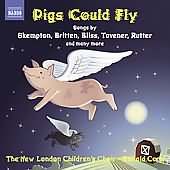Here’s an essential recording for fans of music for treble choir–and for listeners who may never have experienced the highest standard of children’s choir singing and repertoire. The excellent program is varied and very sophisticated while offering the exuberance and spirit we expect from young singers in music perfectly suited to their voices and to the child’s particular love of all things funny, frightful, and fanciful, conveyed by beautiful tunes and engaging rhythms.
Humor (and a healthy dose of nonsense) frames the program, beginning with Howard Skempton’s Pigs could fly (to his own text) and ending with a set of short pieces by Nicholas Maw titled Calico Pie. This includes such songs as “We’re all in the dumps” and “Did you ever” (with lines like “Did you eever iver ever in your leaf life loaf/See the devil divil devil kiss his weef wife woaf?”–you owe it to yourself to hear how Maw deals with those words!).
In between are Britten’s Corpus Christi Carol (adapted from his choral variations A Boy was Born) and clever version of the madrigal text “Now is the month of maying”, Vaughan Williams’ lovely setting of a Shakespeare text, Dirge for Fidele, some splendidly written pieces by New London Children’s Choir founder/conductor Ronald Corp (the set of Flower Songs, to texts by Robert Herrick, is outstanding), and two song sets by Richard Rodney Bennett–The Aviary (five pieces to texts by Coleridge, Shelley, Tennyson, and John Clare) and The Insect World.
As for the scary stuff, you can’t beat Arthur Bliss’ masterful setting of Shelley’s poem “A widow bird sate mourning” (you can literally hear–and feel–the “frozen wind”!) or Tansy Davies’ Oven in the underworld, or John Woolrich’s No Hiding Place Down There (“A sinner man sat on the gates of hell…”). Peter Maxwell Davies’ Shepherds of Hoy, Bob Chilcott’s The lily and the rose, and Philip Godfrey’s Day by day (the beloved text by Richard of Chichester) are special highlights that certainly will inspire some choral-director listeners to begin an immediate search for the scores.
With only one exception the music here is absolutely first class, worthy of a choir as well-tuned, technically assured, charismatic, and well-rehearsed as the New London Children’s Choir, who bring us more than an hour of uplifting, often unusual, and always memorable singing. The exception, not surprisingly, is John Tavener’s Notre Père, which sounds as if dashed off in a few uninspired minutes; however, the choir makes the absolute best of it. My only other reservation concerns the lack of texts in the liner booklet. You have to go online to find them–which wouldn’t be so bad if locating the correct page were easier. And not all of the texts are available due to “copyright reasons”. But you won’t let any of that stop you, because you can’t wait to hear this–and you certainly won’t be disappointed. Highly recommended! [11/19/2008]
































